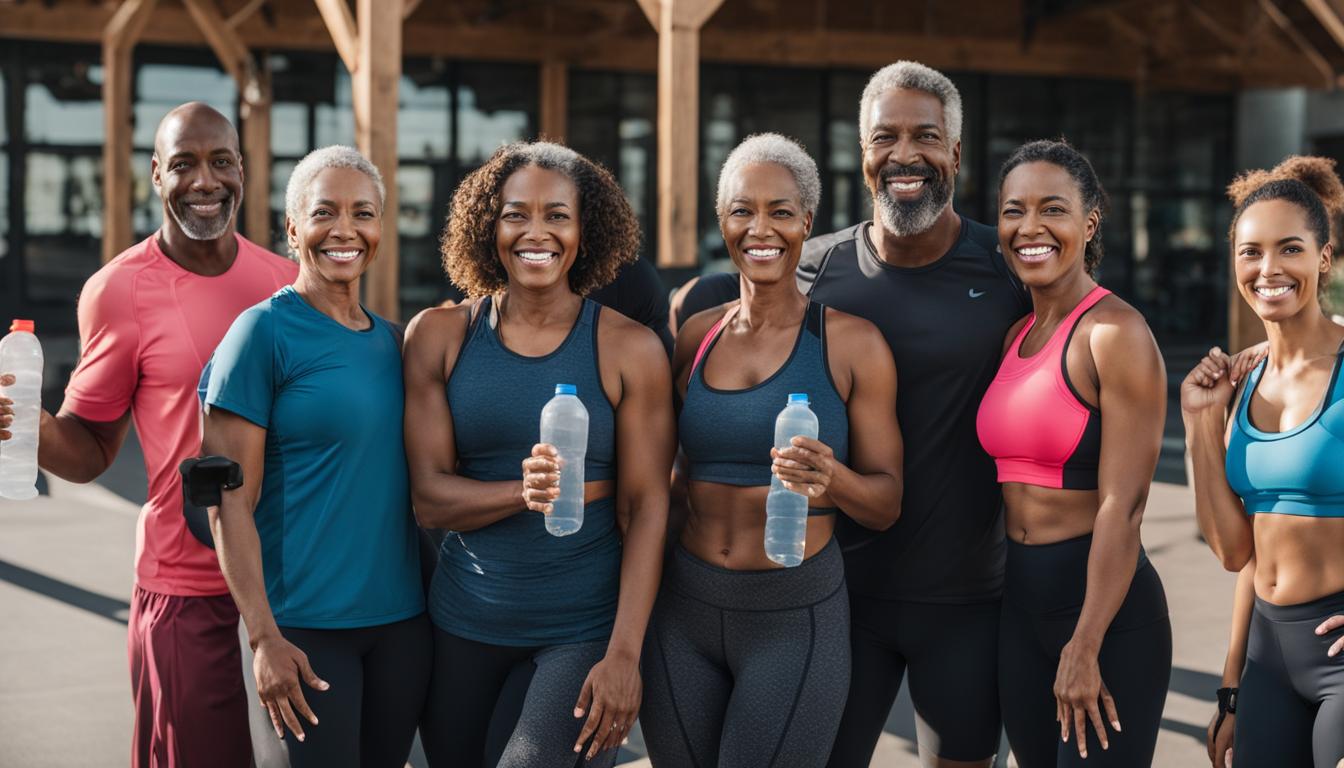As you age, it becomes increasingly important to prioritize your physical health and stay active. Adjusting your exercise routine to accommodate your changing body is crucial for healthy aging. Whether you’re in your 40s, 50s, 60s, 70s, or beyond, there are safe and effective ways to maintain your fitness and well-being.
Key Takeaways:
- Maintaining physical activity is crucial for healthy aging.
- Adjust your exercise routine to avoid injuries and accommodate your changing body.
- Consult with your doctor before starting any exercise program, especially if you have chronic conditions or take medications.
- Walking, using machines like stationary bikes and ellipticals, swimming, and strength training are excellent options for seniors.
- Stay mentally competitive and set realistic goals to enjoy the journey of fitness and aging.
The Importance of Exercise in Middle Age
Just because you’re getting older doesn’t mean you have to give up your favorite activities. In fact, staying active becomes even more crucial as you enter middle age. Regular exercise not only helps maintain physical fitness but also promotes mental well-being and overall quality of life.
As you age, it’s important to know your limits and listen to your body. Muscles and tendons tend to tighten with age, making injuries more common. To minimize the risk of sports-related injuries, it’s essential to incorporate certain strategies into your exercise routine.
First and foremost, warming up is key. It helps prepare your body for the physical demands of exercise and reduces the chances of muscle strains and sprains. Additionally, incorporating flexibility exercises, such as stretching or yoga, can improve joint mobility and reduce the risk of injuries. Weight machines can also be a safer alternative to free weights, as they provide stability and support during strength training.
Lastly, it’s important to choose the right activities for your body. Opt for low-impact exercises like swimming, cycling, or walking, which are easier on the joints while still providing cardiovascular benefits. Remember, staying active past 50 is not only possible but also enjoyable when you prioritize injury prevention and choose exercises that suit your body’s needs.
Benefits of Exercise for Seniors
As we age, maintaining a healthy lifestyle becomes increasingly important. Regular exercise plays a vital role in senior wellness, promoting physical strength, mental well-being, and overall quality of life. Engaging in exercise for seniors can help maintain muscle tone, improve cardiovascular health, enhance bone density, and boost energy levels. It is crucial to consult with your doctor before starting any exercise program, especially if you have chronic conditions or take medications that may impact your fitness routine.
There are various activities that seniors can incorporate into their exercise regimen to stay active and enjoy the benefits of a healthy lifestyle. Walking is a low-impact exercise that can be easily integrated into daily routines, promoting cardiovascular health and strengthening muscles. Additionally, using machines like stationary bikes and ellipticals provides a gentle yet effective way to improve endurance and overall fitness.
Strength training exercises, such as lifting weights or using resistance bands, are valuable for maintaining muscle mass and bone density. These exercises also help improve balance and reduce the risk of falls, which can be particularly important for seniors. Swimming is another excellent option, offering a low-impact workout that engages the entire body without putting stress on joints.
Exercise for Seniors: Key Benefits
- Improves cardiovascular health and endurance
- Helps maintain muscle tone and bone density
- Enhances balance and flexibility
- Boosts mood and mental well-being
- Reduces the risk of chronic diseases, including heart disease and diabetes
By participating in regular exercise, seniors can enjoy a wide range of physical and mental benefits. It is important to start with exercises that are appropriate for your fitness level and gradually increase intensity and duration. Remember to listen to your body and make modifications as needed to avoid injuries. With a commitment to fitness and an active lifestyle, seniors can thrive and enjoy a fulfilling and healthy journey of aging.
Tailoring Exercise to Your Life Point
As you age, your fitness needs change, and it’s crucial to adapt your exercise routine to align with your current life stage. Understanding the impact of hormonal shifts, decreased bone density, increased stress levels, and changes in sleep patterns can help you tailor your fitness approach intelligently to support your overall well-being.
Adjusting Intensity and Impact
One key aspect of adapting your workout routine is considering the intensity and impact level of your exercises. While it’s essential to challenge yourself physically, it’s equally important to listen to your body and avoid overexertion or high-impact activities that may put unnecessary strain on your joints. Incorporating low-impact exercises such as swimming, cycling, or using an elliptical machine can provide a gentler yet effective workout option.
Cardio, Strength, and Mobility
To maintain a well-rounded fitness regimen, it’s important to incorporate cardio, strength training, and mobility exercises. Cardiovascular exercises, like brisk walking or jogging, can help improve heart health and endurance. Strength training exercises, using weights or resistance bands, can help maintain muscle mass and promote bone health. Additionally, including mobility exercises, like stretching or yoga, can improve flexibility, balance, and range of motion, supporting overall functional fitness.
Preparing for the Next Stage
Adapting your exercise routine to your life point not only helps you maintain your current fitness level but also prepares your body for the next stage of life. By making intelligent exercise choices now, you can improve your overall fitness, mobility, and resilience as you continue to age. Remember, it’s essential to consult with a healthcare professional or a certified fitness trainer to create a personalized workout plan that addresses your unique needs and goals.

Injury Prevention and Prehabilitation
When it comes to maintaining a fit and active lifestyle as you age, injury prevention is crucial. By incorporating prehabilitation exercises into your fitness routine, you can reduce the risk of injuries and keep your body strong and resilient. Prehabilitation exercises focus on strengthening key muscles, improving flexibility, and enhancing coordination, all of which contribute to injury prevention.
One effective prehabilitation exercise is yoga. Yoga not only improves flexibility but also helps to strengthen your core muscles, improve balance, and enhance body awareness. Another beneficial exercise is foam rolling, which releases tension in the muscles, improves blood flow, and aids in recovery. Additionally, incorporating weight training into your routine can help build strong muscles and bones, providing added protection against injuries. Remember to perform exercises that target different areas of the body and focus on proper form to maximize their benefits.
Proper warm-ups, mobility exercises, and muscle activation techniques are also essential in injury prevention. These activities prepare your body for the workout ahead, increase blood flow to the muscles, and improve joint mobility. By taking the time to properly warm up and activate your muscles, you can significantly reduce the risk of strains, sprains, and other injuries.
Adjusting Goals and Expectations
As you age, it’s crucial to be kind to yourself and adjust your expectations. Understand that you may not be able to perform at the same level as when you were younger, and that’s okay. Instead of trying to compete with your younger self, focus on setting achievable goals and continue building from there. The key is to stay mentally competitive and enjoy the journey.
Self-compassion is essential when it comes to staying active in your 40s, 50s, and beyond. Embrace the changes that aging brings and be patient with yourself as you adapt to a new phase of life. Remember that staying fit and healthy is a lifelong journey, and it’s never too late to start or make adjustments.
“Setting realistic goals is crucial when it comes to fitness and aging. It’s important to understand your current capabilities and limitations and work within those parameters. By focusing on what you can achieve and making progress at your own pace, you’ll be more motivated and less likely to get discouraged.” – Dr. Jane Johnson, Fitness Expert
Competing with yourself can be a powerful motivator. Instead of comparing yourself to others, use your past achievements as benchmarks and strive to improve upon them. Celebrate your progress, no matter how small, and take pride in your ability to stay active and maintain a healthy lifestyle.
Practical Tips:
- Set specific, measurable, and attainable goals that align with your current abilities.
- Break larger goals into smaller milestones to track your progress.
- Listen to your body and adjust your routine accordingly, allowing for rest and recovery when needed.
- Find activities that bring you joy and make them a regular part of your fitness routine.

Importance of Sleep for Optimal Performance
Sleep plays a crucial role in maintaining your physical and mental well-being, especially as you age. Getting enough quality sleep is essential for optimal performance in your fitness journey. Lack of sleep can lead to fatigue, decreased cognitive function, and impaired physical abilities, all of which can hinder your progress and overall performance. It is important to prioritize sleep as part of your fitness routine and ensure you are getting the recommended amount of rest.
Research has shown that sleep deprivation can have a negative impact on your body’s functioning. It can affect your immune system, making you more susceptible to illnesses and infections. Lack of sleep also impairs your body’s ability to recover and repair itself after exercise, leading to increased muscle soreness and slower progress. Furthermore, inadequate sleep can impact your mood, motivation, and mental focus, making it harder to stay consistent with your fitness goals.
Creating a sleep routine and following good sleep hygiene practices can help improve your sleep quality. Set a consistent sleep schedule, create a relaxing bedtime routine, and create a sleep-friendly environment by keeping your bedroom dark, cool, and quiet. Avoid stimulating activities, such as using electronic devices or consuming caffeine, close to bedtime. Taking steps to prioritize sleep will not only enhance your physical performance but also contribute to your overall well-being and quality of life.
The Impact of Sleep on Exercise Recovery
“Sleep is essential for the recovery process after exercise,” says Dr. Jane Thompson, a sleep expert. “During sleep, your body repairs damaged tissues, restores energy levels, and consolidates memories. It is also during sleep that the release of growth hormone occurs, which is important for muscle growth and repair.
In addition to physical recovery, sleep plays a vital role in mental recovery as well. “Sleep is necessary for cognitive function and emotional regulation,” says Dr. Thompson. Getting enough sleep enhances your ability to focus, make decisions, and manage stress, all of which are important factors in maintaining a healthy fitness routine.
So, while it’s tempting to sacrifice sleep in order to fit in more workouts or other activities, it’s important to remember that rest and recovery are just as important as the exercise itself. By giving your body the rest it needs, you’ll be setting yourself up for success in achieving your fitness goals and enjoying a healthier, more balanced lifestyle.

Embracing New Challenges and Activities
Age should never be a limitation when it comes to trying new things and embracing challenges. As we get older, it’s important to keep our bodies and minds active to maintain a sense of personal growth and fulfillment. Trying new activities not only keeps us physically fit but also expands our horizons and brings a sense of adventure to our lives.
Whether it’s taking up a new sport, learning a musical instrument, or exploring a new hobby, the possibilities are endless. Engaging in new activities can help us break free from our comfort zones, discover hidden talents, and foster a sense of curiosity and excitement. It’s never too late to pursue a passion or explore a new interest.
As we age, staying active becomes increasingly crucial not only for our physical health but also for our mental well-being. Trying new activities challenges us, helps us build resilience, and boosts our self-confidence. It provides an opportunity to meet new people, make new friends, and become part of a community that shares our interests.
Benefits of Embracing New Challenges:
- Enhances cognitive function and brain health
- Improves physical fitness and flexibility
- Boosts mood and reduces stress
- Increases social interaction and connection
- Fosters a sense of purpose and personal growth
So, don’t let age hold you back. Embrace the opportunities that come your way, step out of your comfort zone, and challenge yourself to try new activities. Remember, the journey is just as important as the destination, and every experience, big or small, contributes to a vibrant and fulfilling life.
The Power of Community and Support
When it comes to staying motivated and accountable in your fitness journey, the power of community and support cannot be underestimated. Surrounding yourself with like-minded individuals who share similar goals and experiences can make a significant difference in your ability to stay active and committed to your fitness routine.
Joining a fitness community can provide you with the motivation and encouragement you need to push through challenging workouts and overcome any obstacles that come your way. Whether it’s a local fitness class, a running group, or an online community, connecting with others who are on a similar fitness journey can help you stay engaged, inspired, and focused on your goals.
Being part of a supportive community also provides a sense of accountability. When you know that others are counting on you to show up and give your best effort, it can be a powerful motivator to stay consistent with your exercise routine. The encouragement and support from your fitness community can help you stay motivated, celebrate your achievements, and overcome any setbacks along the way.
The Benefits of Joining a Fitness Community:
- Increased motivation and inspiration
- Opportunities for social interaction and connection
- Access to advice, guidance, and expertise from fellow fitness enthusiasts
- Accountability and support to stay consistent with your fitness routine
- A sense of belonging and camaraderie
“Being part of a fitness community has been a game-changer for my fitness journey. The support and encouragement I receive from fellow members have kept me motivated, and I’ve made lifelong friendships along the way.” – Sarah, a fitness enthusiast.
Whether you prefer in-person interactions or virtual connections, there are numerous ways to find and join a fitness community that suits your needs and interests. Explore local fitness clubs, social media groups, online forums, or even create your own fitness network. Embrace the power of community and support to enhance your fitness journey and make staying active a fun and fulfilling experience.

The Role of Nutrition and Supplementation
Good nutrition plays a vital role in supporting overall health, especially as we age. Eating a well-balanced diet that is rich in essential nutrients is key to fueling our bodies and maintaining optimal function. Adequate intake of vitamins, minerals, and antioxidants is crucial for bone health, muscle strength, and immunity.
In addition to a healthy diet, supplementation can be beneficial for older adults. Effective supplementation can help fill nutritional gaps and support specific health needs. For example, vitamin D and calcium supplements can promote bone health and reduce the risk of fractures, especially in individuals who have limited sun exposure or are at a higher risk of osteoporosis.

Consulting with a healthcare professional or a registered dietitian can help determine the most effective supplementation plan based on individual needs and health conditions. They can provide personalized recommendations and guidance to ensure that the supplements chosen are safe and suitable for each person’s unique circumstances.
The Mind-Body Connection
Taking care of your mental well-being is just as important as physical fitness. The mind and body are intertwined, and nurturing both aspects can lead to a more balanced and fulfilling life. Mind-body exercises, such as yoga and meditation, provide a powerful way to cultivate this mind-body connection.

Yoga, with its combination of physical postures, breath control, and meditation, helps reduce stress levels and improve overall mindfulness. It encourages you to be present in the moment, focusing on your breath and body sensations. This practice can bring a sense of calm and relaxation, allowing you to let go of worries and connect with your inner self.
Meditation, on the other hand, involves training your mind to achieve a state of deep relaxation and heightened awareness. Through various techniques like guided imagery, mantra repetition, or mindfulness meditation, you can learn to quiet the mind, observe your thoughts without judgment, and cultivate a sense of inner peace and clarity.
The Benefits of Mind-Body Exercises
Mind-body exercises offer a multitude of benefits for your mental well-being. They can:
- Reduce stress levels and promote relaxation
- Improve focus and concentration
- Enhance self-awareness and mindfulness
- Boost mood and emotional well-being
- Promote better sleep
- Reduce symptoms of anxiety and depression
Engaging in mind-body exercises allows you to create a peaceful sanctuary within yourself, where you can find solace, rejuvenation, and a deeper connection to your inner wisdom.”
By incorporating mind-body exercises into your routine, you can enhance your overall well-being and find a sense of harmony between your mind and body. Whether it’s through a yoga class, a guided meditation app, or simply taking a few moments each day to focus on your breath and be present, these practices can help you navigate life’s challenges with greater ease and serenity.
Conclusion
Aging is a natural part of life, but it doesn’t mean you have to give up on staying active and healthy. By understanding your body’s needs, adapting your exercise routine, prioritizing rest and recovery, and seeking support from communities and professionals, you can embrace a fit aging journey that allows you to thrive physically and mentally. Remember, it’s about finding what works for you and enjoying the process every step of the way.
As you age, staying physically active becomes increasingly important. Adjusting your exercise routine to avoid injuries is crucial. Whether you are in your 40s, 50s, 60s, 70s, or beyond, there are safe and effective ways to stay fit and healthy.
Surrounding yourself with a supportive and like-minded community can make a significant difference in your fitness journey. Being part of a group that shares similar goals and experiences can provide motivation, accountability, and companionship. Whether it’s joining a fitness class, participating in local events, or connecting with fellow enthusiasts online, community support plays a crucial role in staying active and motivated.
Aging is a natural process, but it doesn’t mean you have to let go of your fitness and well-being. With the right mindset, a tailored exercise routine, proper nutrition, and support from others, you can continue to stay active in old age and enjoy a fulfilling and vibrant life.
FAQ
Why is staying physically active important as you age?
Staying physically active as you age is important for maintaining overall health, preventing chronic conditions, and preserving mobility and independence.
What adjustments should be made to exercise routines to avoid injuries?
It is crucial to adjust exercise routines to avoid injuries by warming up, incorporating flexibility exercises, considering weight machines, and choosing the right activities.
What activities are recommended for seniors to stay fit?
Walking, using machines like stationary bikes and ellipticals, swimming, and strength training are all excellent options for seniors to maintain muscle tone, bone density, and overall well-being.
How should fitness routines be aligned with age-related changes?
Fitness routines should be aligned with age-related changes by incorporating cardio, strength training, and mobility exercises while adjusting the intensity and impact level.
What are prehabilitation exercises, and how can they prevent injuries?
Prehabilitation exercises such as yoga, core exercises, foam rolling, and weight training can improve strength, flexibility, and coordination, reducing the risk of injuries in older adults.
How should expectations be adjusted as you age?
Expectations should be adjusted by setting achievable goals instead of trying to compete with your younger self, focusing on personal growth and enjoying the fitness journey.
Why is sleep important for optimal performance and recovery?
Sleep is crucial for optimal performance and recovery as it supports physical function, mental well-being, and overall performance in exercise and daily life.
Can seniors try new activities and embrace challenges?
Yes, seniors can try new activities and embrace challenges to maintain a sense of personal growth and keep moving throughout their lives.
How does community support contribute to staying active?
Surrounding yourself with a supportive and like-minded community provides motivation, accountability, and companionship, which play a crucial role in staying active and motivated.
How can nutrition and supplementation support fitness and aging?
Proper nutrition and supplementation, including nutrients like Vitamin K2 and a well-balanced diet, can have a positive impact on overall health and support fitness goals in older adults.
How do mind-body exercises benefit fitness in older adults?
Mind-body exercises such as yoga and meditation help reduce stress levels, improve focus, and enhance overall mindfulness, contributing to a balanced and fulfilling fitness journey as you age.
Can aging adults still stay active and healthy?
Yes, aging adults can stay active and healthy by understanding their body’s needs, adapting their exercise routine, prioritizing rest and recovery, and seeking support from communities and professionals.


